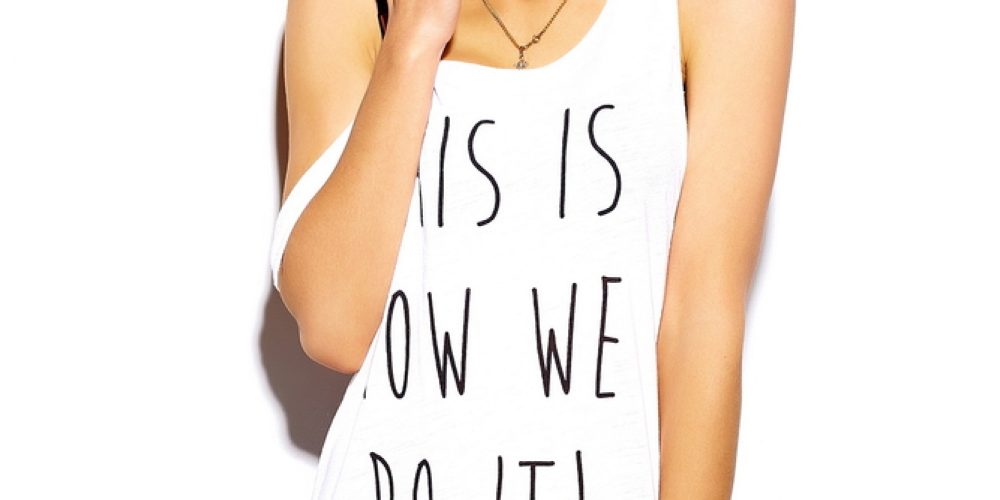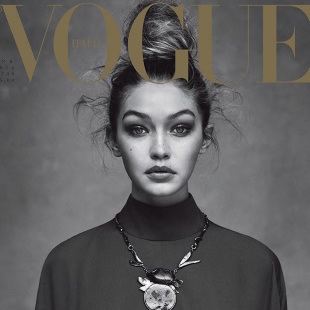Go see them:
If the agency has open calls, or allows models to personally drop off pictures, or you can get an appointment, do that if
possible. Pictures are good, but seeing you in person is better. There are lots of examples of people who would have been turned down from their pictures, but who were accepted when somebody actually laid eyes on them in person. When you go to see them, wear form-fitting clothes that let the agency get a sense of your body proportions. Dress “upscale casual” if possible. This is a job interview, and you don’t want to make a bad impression. Wear normal daytime makeup or, for fashion agencies, less makeup than that.
Send them an application:
If the agency does not accept walk-ins, don’t do it. It’s annoying, and nobody wants to start off that way. If you must,
send in an application. Most agencies have a “Christmas File”. That’s a private file that they put the truly awful pictures into. Pictures that are sent by people who want to be accepted as models. Some are so bad that they are good for a chuckle, or even a hearty belly laugh, and what better time to break them out than the holidays. Then there is the “round file”: the trash can. The great majority of all submissions end up there. A lot of people would be consigned to the trash no matter what they did, but some of them don’t have to be. It’s possible to give yourself a fighting chance. If you don’t want to end up in one of those files, pay attention. Here’s what people do wrong, and what you should do right.
What Should Be in the Application:
1. Keep it simple. The agency wants to know what you look like, what your height and stats (for women, bust/waist/hips, for men, suit jacket, inseam and waist size) and location and age are. You should include eye color, hair color, dress and shoe size as well, since they may help. If you are currently represented by a real, booking agency somewhere, say so.
2. If you have extensive professional modeling or acting experience, say so. Very briefly. If the basics interest them, they may want to know a lot more about you. But they will ask. Don’t force it on them at the beginning. It simply wastes their time and yours, and you may include things that will hurt you, not help. They do NOT want to know that you have dreamed of being a model your whole life, that you were third runner up in a local beauty pageant, or which high school plays you were in. They aren’t interested in how many callbacks you received at some model convention. Do not tell them you are a graduate of modeling school. They also don’t want to know about all the websites you appear on, and don’t care that some “model exposure” site showcased a picture of you.
3. Include contact information. At a minimum, your telephone number. If you want to also include your address and email address you can.
4. Don’t ask them to contact someone else about you. They want to talk to you (or, if you are a minor, your parents).
The worst thing you can do is say “for further information please call my other agent at . . . .”
5. If you are not a citizen of the country you are applying to, explain what your visa status is. You must have the legal
right to work, and the agency needs to know if you do, or if it’s a problem that needs to be taken care of.
6. If you don’t live near the agency, explain what your plan is, briefly. Sooner or later you are going to have to go see them. Tell them about that. If you don’t plan to move, don’t bother sending an application.
7. Include the right kind of pictures. Nobody wants to see pictures you happened to have lying around of your vacation,
your prom, or snapshots of you and your friends at a bar. Make it look like you at least tried to send something specifically tailored for this purpose. If that means getting a disposable camera and taking a trip to the drug store, do it.
Pictures
The best possible pictures to send are tearsheets of you in prestigious, paid modeling work of the kind the agency does.
Shots from Vogue or a national ad campaign beat snapshots every time. But most of you won’t have those. If you don’t, call and ask the agency what they prefer. Some (mostly fashion agencies) will want only simple Polaroid-style snapshots. Others (primarily commercial agencies) would prefer well-developed composite cards or similar professional pictures. Still, paying lots of money for those professional pictures may not be a good investment. It’s wise to try an inexpensive approach first. Only after that hasn’t worked and you are still determined to pursue modeling should you invest in professional pictures.
Many aspiring models know what an agency’s stated preference for pictures is, but decide to go ahead and get a
portfolio anyway. That can hurt a model’s chances, not help. Here’s why: «Pictures better than snapshots» have to be excellent professional images of the sort the agency uses. If they are the wrong style for his market, they fail may make you look like the wrong kind of model who cannot be what he needs models to be.
The classic dichotomy is «fashion» vs. «commercial». If a model walks into an editorial agency with a bunch of excellent
commercial style pictures, she will be immediately categorized as «too commercial» and rejected. If she walks into a commercial agency with excellent editorial fashion pictures she may well be told she is «too editorial» and rejected. The style of picture defines what you are, unless it is clearly a snapshot. There is another problem. If you submit snapshots it will be evident that you are not an experienced model. That’s not good, but it’s not a fatal flaw. If you submit “professional pictures” and try to look experienced, and the pictures are bad, it says to them that you aren’t a person who can attract real paying jobs. Most “professional portfolio pictures” are bad. Snapshots are better. No matter whether you use snapshots or professional pictures, keep them to a minimum (three is a good number) and be selective in what you sent. You are only as good as your worst shot.
How to Submit Your Application:
Send them a mail application:
The best thing to do is send a postal application. It should include pictures and the information described above. If you want the pictures back, include a stamped, self-addressed envelope. Make sure you write your name, contact information and stats on the back of every picture.
Email:
Before you send an agency email, check with them by phone, or on their website. Very few agencies prefer email, although
these days many will accept it. Some will not. Most would rather get pictures and stats in regular postal mail. Here’s why:
1. Many models don’t know how to send an effective email. They send pictures in formats the agency can’t read, they
send pictures that are so large they clog the system and won’t fit on the screen. They send pictures so small nobody could tell what the model looks like. They send pictures only, with no contact information except a return email address. (Yes, that’s a problem. Agencies want to know where you are.) They send emails with no pictures and request the agency email for them if interested (fat chance!). People with AOL send pictures as attachments. AOL won’t let you send pictures to non-AOL subscribers as attachments, so the email arrives with text only. Or they do things like say, “I’ve been hearing wonderful
things about your agency and would love to work with you.” Then the message header shows that it was sent to 47 agencies
around the world, including four well-known scams. Or they have the message enclosed in another message, sometimes three or four layers deep. After clicking on all those other emails to get to the message, the pictures had better be
wonderful.
Or they ask the agency to go to some goofy site with six popup ads per page, and the agent has to wade through pages of
pictures of the model’s boyfriend, puppy and prom night, plus read all about her favorite foods, her best friends and the poetry she likes to write. Somewhere on the site there might actually be pictures of the model and her stats, but it takes time to find it. Long before that happens the agent is on to the next email.
2. Agencies get lots of spam and viruses. Agency email addresses are harvested by spammers and show up in lots of
people’s computers, so it’s not unusual for an agency to get hundreds of spam messages, and several to hundreds of viruses
every day in their email. They don’t want to pay someone to go through all that, so they use automated virus and spam filters to get rid of most of their email. Lots of model submissions look like spam, and are deleted before they are ever read. Some of them with attachments are treated as viruses. Nobody wants to open attachments from someone they don’t know.
3. Email inboxes get clogged. Agencies get so many submissions (and spam, and viruses) that their inbox can get full
and they may never see your email.
4. It’s harder to file your submission and show it to other people. No, it’s not impossible. But pieces of paper are easier to
deal with. They fit in file folders that can be passed around. Yellow stickies can be added to them. For all the talk of the
“paperless office”, paper is still easier to deal with. You don’t want to make it harder. Except when time is critical and somebody at the agency is expecting something from you, it is almost never the best idea to send email. Use the post office
If you absolutely have to use email, do it right:
1. Include pictures embedded in the body of the message, or by hyperlink. The link should be to the pictures themselves,
not to some website that the pictures are on.
2. Make sure the pictures are the right size and format. They should be 450-600 pixels high, and in JPEG format only. Do not ZIP or STUFF anything. Do not embed it in some other document like a word processing document or .pdf file. If you don’t know what any of this means, or how to do it, find someone who does, or don’t send email!
3. Send an email to each agency individually. It’s not that hard. Nobody likes to get an email submission that is sent to
everyone else he knows and some he doesn’t want to know.
4. If you feel you absolutely have to send the agency a link to your website, make sure it is the same as what your submission should be: simple and to the point. Don’t make anyone wade through extraneous information or click on lots of pages to find what they need. Put it on the first page. Put nothing else on that page.
Telephone:
For the most part, the telephone is for asking questions. You can use it to find out if the agency has open calls, how to send submissions, what they want to see, what their requirements are. You might be able to make an appointment to come in to see them, but at most agencies you won’t be able to.
Call during business hours. Every agency gets calls from aspiring models who leave messages at odd times of the night,
usually asking for a return call. They get ignored. If you can’t call the agency when it is open for business, you can’t be a model.
Call for yourself! (Or, if you are very young, have your parents call for you.) If you have your cousin, some “manager”
nobody has ever heard of or, worse, your boyfriend call for you, you are already at a serious disadvantage. The agency wants to know why you aren’t calling for yourself (are you not able to? Are you not interested enough?) and if they have to deal with some meddlesome intermediary in working with you. Don’t give them that impression.
What Happens Next?
Nobody will contact you unless they are interested in you. Within minutes after they look at your application they will have
forgotten it unless they are interested. Usually if you call and ask if they have gotten it, they won’t know. Nobody logs and tracks those things. There are too many of them to remember or keep track of.
If you don’t get a response within a couple of weeks you probably aren’t going to. At that point you can think about trying
again, but by doing something differently: get different pictures or go see them instead of just making a mail submission. If after all that you still aren’t getting a response, it’s probably time to forget that agency…






